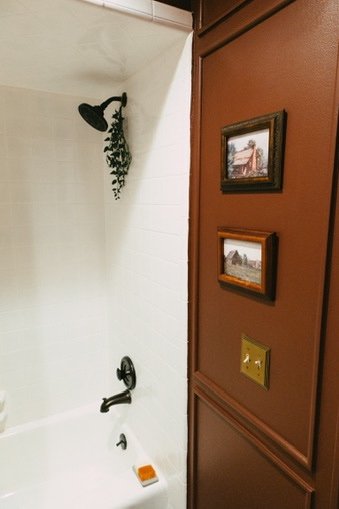Why Your Showerheads and Faucets Probably Need To Be Cleaned
Maintaining a clean home is more than just a matter of aesthetics; it’s essential for health and functionality. Among the often-overlooked items in household upkeep are showerheads and faucets. These fixtures, though frequently used, can accumulate grime and build-up that can impact both their performance and your health. In this guide, we’ll explore why cleaning these fixtures is important, what happens if you neglect them, best practices for cleaning, and non-toxic cleaning options.
Why Clean Showerheads and Faucets?
1. Health and Hygiene: Showerheads and faucets are breeding grounds for bacteria, mold, and mildew. The warm, damp environment they create is ideal for microbial growth. Over time, these microorganisms can contribute to unpleasant odors and even cause skin irritations or infections.
2. Efficiency and Performance: Mineral deposits, soap scum, and other residues can clog the small openings in showerheads and faucets. This clogging can reduce water pressure and result in uneven water flow. For showerheads, this can mean an unsatisfactory shower experience, while for faucets, it can lead to less effective rinsing.
3. Longevity of Fixtures: Regular cleaning can help extend the life of your fixtures. Mineral build-up and corrosion can deteriorate the finishes and internal components, potentially leading to costly repairs or replacements.
What Happens If You Go Too Long Without Cleaning?
If you don’t regularly clean your showerheads you may notice low water pressure. Hard water contains minerals like calcium and magnesium that can build up inside your showerhead and faucet. This build-up narrows the pathways through which water flows, reducing water pressure and making showers and taps less effective. They may also smell! Soap scum and mildew can stain your fixtures, making them look dirty and unappealing. Additionally, stagnant water or mold growth can cause unpleasant odors that linger in your bathroom or kitchen. The warm and damp environment can encourage the growth of harmful bacteria and fungi, which can be transferred to your skin during use, potentially causing health issues.
Best Practices for Cleaning Showerheads and Faucets
Regular Maintenance: To prevent significant build-up, clean your showerhead and faucet at least once a month. This frequency helps keep mineral deposits and grime in check.
Descaling Solution: Use a descaling solution or a mix of equal parts vinegar and water to tackle mineral build-up. Soak a cloth in the solution and wrap it around the fixture. Let it sit for about 30 minutes to an hour, then scrub with a soft brush or cloth.
For Showerheads: Detach the showerhead (if possible) and soak it in the descaling solution for about an hour. For hard-to-reach areas, use an old toothbrush to scrub the nozzles. Rinse thoroughly before reattaching.
For Faucets: For faucets with removable aerators, unscrew the aerator and soak it in the solution. Use a small brush to scrub away any remaining deposits. Rinse everything well before reassembling.
Dealing with Stains: For tougher stains, you may need to use a mixture of baking soda and water or a non-abrasive cleaner. Apply the paste to the stains, let it sit for a few minutes, and then scrub gently with a brush or sponge.
Best Materials to Use for Cleaning
Soft Cloths: Use soft, lint-free cloths to avoid scratching the surface of your fixtures.
Non-Abrasive Brushes: Soft-bristled brushes or old toothbrushes are ideal for scrubbing away build-up without damaging the finish.
Commercial Cleaners: If you prefer commercial products, look for those specifically labeled as safe for use on metal and plastic fixtures, and avoid those containing harsh chemicals.
Non-Toxic Cleaning Options
Vinegar and Water: A simple and effective non-toxic cleaner. Mix equal parts vinegar and water in a spray bottle, and apply it to the fixture. Let it sit for 15-30 minutes, then scrub and rinse.
Baking Soda Paste: Combine baking soda with a small amount of water to create a paste. Apply this paste to stained or dirty areas, let it sit for a few minutes, and then scrub gently.
Lemon Juice: Lemon juice has natural antibacterial properties and can help to break down mineral deposits. Apply lemon juice directly to the fixture or mix it with water for a more diluted solution.
Hydrogen Peroxide: A good alternative for disinfecting. Use a solution of hydrogen peroxide and water to clean and sanitize your fixtures.
How Often to Clean
You should aim to clean your showerhead once a month. This will prevent the build-up of minerals and bacteria and maintain optimal water flow. For faucets, they should be cleaned every 1-2 months, depending on your water quality and usage. High mineral content in water may require more frequent cleaning. If you notice any reduction in water pressure or visible stains, clean the fixture promptly.
Regularly check your fixtures for signs of build-up or damage. Early intervention can prevent more serious issues. Another good tip is to wipe down fixtures after each use to prevent water spots and build-up. This simple step can reduce the need for more intensive cleaning later. I f you’re like me and often forget to wipe it down, installing water filters can help reduce mineral deposits and improve water quality, potentially reducing the frequency of cleaning.
I don’t recommend using harsh chemical for cleaning these fixtures. Steer clear of bleach or abrasive cleaners, which can damage the finish of your fixtures and harm the environment.
By incorporating these cleaning practices into your home maintenance routine, you can ensure that your showerheads and faucets remain functional, hygienic, and visually appealing. Regular care not only enhances the performance of these fixtures but also contributes to a healthier living environment.





